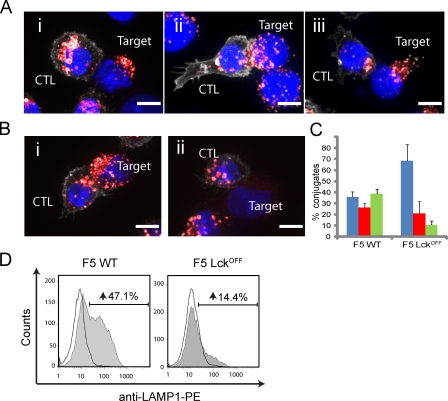Figure 2.
Lck is essential for degranulation and lytic granule polarization toward the immunological synapse. (A) Merged immunofluorescence images of three lytic granule polarization phenotypes seen in F5 CTL conjugates with lytic granules: (i) >90% of granules distal, (ii) dispersed, or (iii) tightly clustered at the synapse. Conjugates are labeled with antibodies against LAMP1 (red) or CD8 (white). Nuclei are stained with Hoechst (blue). (B) Representative images of granule polarization observed in (i) WT and (ii) Lckoff F5 CTL conjugates. (C) Quantitation of granule polarization in F5 WT (n = 465) and Lckoff (n = 484) CTLs for granules that were distal (blue), dispersed (red), or tightly polarized (green) at the immune synapse. Error bars show the standard deviation from the means of at least three independent experiments. A two-tailed Student’s t test for loss of granule polarization in Lckoff samples compared with WT gave a statistical significance of P = 5 × 10−6. (D) Histograms of a CTL degranulation assay displaying a CD8+ cell count against a LAMP1-PE signal upon activation with pulsed (shaded) or unpulsed (unshaded) EL4 targets. The percent increase in LAMP1 staining with a pulsed versus an unpulsed target is given. Data are representative of more than three independent experiments. Bars, 5 µm.

